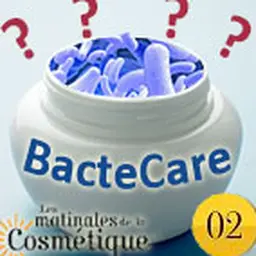
The microbiota, which was the focus of the presentation by Marie-Alice Dibon and Maryelle Allemand at the Matinales de la Cosmétique, has the potential to change the world of cosmetics completely. The concept of ‘good bacteria’ opens up many possibilities, some of which have already begun to be explored, while others remain to be invented. Jean-Claude Le Joliff makes his contribution to the debate in this space, adding some innovative ideas as the specialist that he is.
Allow me to modestly meddle in the debate started by the two brilliant foreseers that CosmeticOBS cited on the concept of ‘good bacteria’. I am allowing myself to get involved because the subject, while I do not fully master it, has held my attention for several years. It is of particular interest because it could give way to a new paradigm in terms of cosmetic product design. This new paradigm would be to purposefully contaminate products to make them better ! I can already hear your reactions…
Probiotics and microbiome
Let’s go back to examine the context in greater detail. This hypothesis is based on two series of considerations, on probiotics and the microbiome.
Probiotics
This sector of activity is the subject of relatively intense research on the part of many teams, both academic and private. The aim of the research is to refine treatment strategies based on probiotics. In 2001, the World Health Organization (WHO) and the Food and Agriculture Organization of the United Nations (FAO) provided
an official definition of probiotics
: these are ‘
live microorganisms, which when consumed in adequate amounts, confer a health effect on the host, beyond traditional nutritional effects’
. The works of these research teams are the subject of debates in several events including Probiotec, now
Probiota, which just took place in Amsterdam
. Communication on cosmetics:
• Cosmetic research and applications
•
Gut-skin microbiota
• Probiotics for reactive skin
• Using probiotics to mitigate dandruff
• Using probiotics to address photodamage
The microbiome
This is international research aiming to take inventory of the microorganisms (the microbiota) and their role in the human ecosystem. This represents a body of research covering both the characterisation and also a genomic research of the bacteria that colonise the human or animal body. Rather than successively sequencing the genomes of each
species
of bacteria, we use the methods of metagenomics, which apply to a complete ecosystem. This also leads us to take a precise inventory. As previously mentioned, several spectacular advances have already been proposed.
The point where the two come together, including the subject of antibacterial preservation, has just turned the spotlight onto this field. Planning to voluntarily contaminate products is entirely legitimate, at least for certain products, as has already been suggested by several specialists, to control pathogenic and undesirable germs. But it goes further than this. Several outcomes are possible.
Sterility is no longer the goal
The approach would first put an end to the current paradigm, strongly defended by the proponents of conformism, and which holds that products must be sterile or nearly so to avoid problems. This has led to the tyranny of the ‘challenge test’ and the misguided dosage of antibacterial preservatives in many products. The tip of the iceberg was the paraben crisis.
Reconsidering this dogma would perhaps make it possible to consider solutions other than those known to date. As suggested by Maryelle Allemand, designers have already begun to work on ‘living’ creations that use bacteria. This is what we’re talking about.
As an extension of this idea of a cutaneous ecosystem, let’s not forget that the skin manufactures its own antibacterial agents, defensins (CERIES Research Award 1998), and other highly specific peptide antibiotic molecules. Several substances are available that make it possible for these molecules to be expressed in the skin (BASF, SILAB, and others).
In recent and known examples of application, many go against the usage of bactericides and similar substances. Take, for example, the bacteria-based anti-cavity toothpastes already available on the American market; traditionally the goal was to kill germs. The new paradigm therefore focuses on life rather than on sterility!
Stabilisation
One of the central questions of this type of approach resides in controlling and stabilising contaminations. The stabilisation of bacterial species in formula environments is admittedly problematic, but several teams are working on this issue. To compensate for the drawbacks, the EBInnov team from the École de Biologie Industrielle (School of Industrial Biology), in association with a company called Kloarys Développement, proposed a reasoned approach that earned recognition from Cosmetic Valley: the Ecosmetic project . The approach involves selecting ingredients that allow anaerobic germs to survive over a period of several months. Other, similar projects also exist, which should result in applicable technical solutions.
Towards immuno-cosmetics
In addition, the idea of good bacteria makes it possible to imagine an interesting concept that could be called ‘immuno-cosmetics’. Indeed, in an analogy with the intestinal mucous membrane, the skin, which presents several similarities with the intestinal epithelium, is a secretory organ. Getting it to produce, under the influence of properly selected microorganisms, tissular messages that can have beneficial effects is not a utopian pursuit. Take, for example, the remarkable work carried out by a Sanofi team (subject of an upcoming Cosmétothèque publication) that led to the demonstration that we can induce, through specific yeasts, the expression of specific interleukins that lead to the acceleration of epidermal turnover. It’s like an acid-free peel! Nearly everyone has forgotten about this, but it’s never too late to do the right thing.
New ‘organic cosmetics’?
Finally, all of this could make up the first step in an approach to integrating the concept of bioremediation in the world of cosmetics. We already know about Moringa seeds for purification, and we’re ready to go further.
Could this be the beginning of truly organic cosmetics? Up until now, the concept of ‘organic’ has referred only to the origin of the ingredients. But using biological systems to improve performance would be much more elegant.
Jean-Claude Le Joliff














